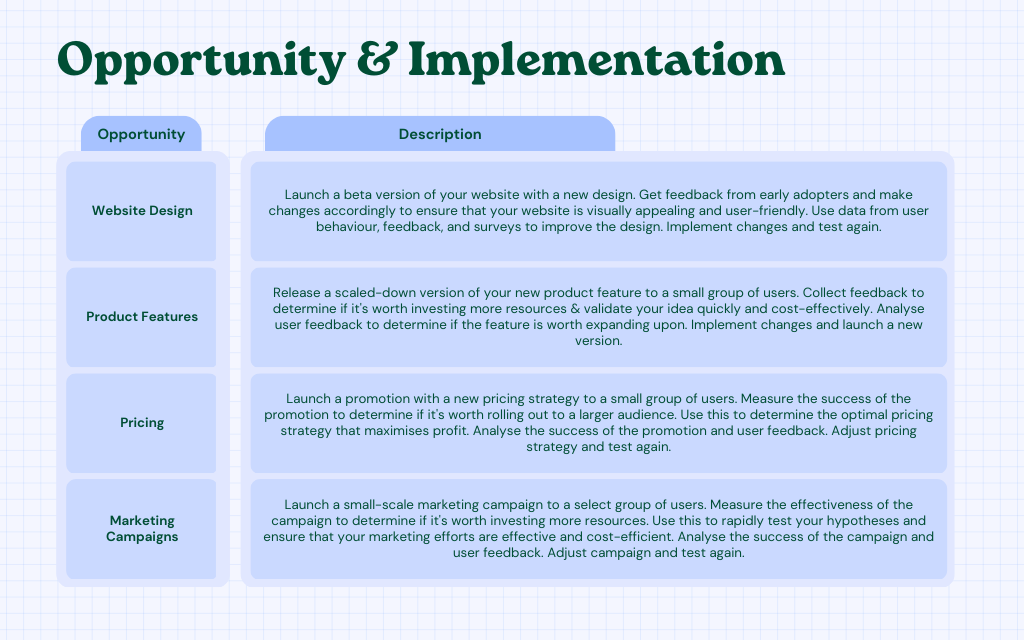Picture this: It’s 3:30pm on Friday afternoon and a member of your team suggests that you launch audience-specific landing pages in attempt to increase conversion rate. You know that your developers are all tied up in their current projects and taking away from the original plan may harm your business. You sit on the idea over the weekend and then decide that it’s simply not possible at this time. What if it was?

If you’re running an e-commerce business, you know that optimising your website and marketing efforts is crucial for the long-term success of the business. Testing new ideas is imperative to making it work but due to lack of resource, the low-hanging fruit can sometimes fall from the tree and be left to rot. In this article, we’re going to introduce you to Minimal Viable Testing (MVT), a cost-effective way to validate new ideas and make data-driven decisions without breaking the bank. We’ll break down what Minimal Viable Testing is, how to launch your first test, why you should launch your first test, gathering results, and the ongoing process to insert this system into your ways of working.
What is Minimal Viable Testing
Minimal Viable Testing (MVT) is a method of testing a product or a new feature with a minimum amount of resources. Popular in the start-up world, it involves launching a “scaled-down” version of your product or feature targeted at a select group of users in order to gather feedback and determine if it’s worth investing more resources into the idea going forward. Think of it as building a house. You start with a small-scale model to test out the design and functionality before moving forward to gather feedback from peers. You then decide if it is worth making the necessary adjustments before building the full-scale house or scrapping the idea and going back to the drawing board. MVT is this process over and over again, without sacrificing brand reputation or any core values.

Why Should You Use Minimal Viable Testing?
Using the minimal viable testing framework has several benefits. Firstly, it helps you to validate new ideas quickly and cost-effectively, saving you time and money. It also allows you to make data-driven decisions based on user feedback, rather than assumptions or intuition. How many times have you launched a full-scale idea, waited months to launch, to only realise that the idea is not as refined as it needs to be? MVT results in a more optimised product or feature, which increases user satisfaction and loyalty. Furthermore, launching ongoing ideas as rapid Minimal Viable Tests can help you to identify and solve potential problems early on, before they become major issues. It’s building the plane whilst flying it.
How to Use Minimal Viable Testing
Launching minimal viable testing requires a few key steps:
- Identify the problem or opportunity you want to address: This could be anything from improving website conversion rates to testing a new product feature. This starts from the current customer feedback and data in order to determine the area of opportunity which will deliver the highest impact in the shortest timeframe.
- Define your hypothesis: What do you believe will happen if you make a certain change or improvement? What outcome are you hoping to achieve?
- Create a simplified version of your product or feature: This should include only the essential elements needed to test your hypothesis. You can determine if third party tools can help you launch faster before involving developer resource. You can make a note of aspects which may impact the results but you consciously chose not to include.
- Launch your test to a small group of users: This could be done through email, social media, or other targeted marketing channels, or an A/B test targeting a low percentage of users.
- Collect feedback and data from your users: Use surveys, user testing, or other feedback mechanisms to gather information about how your users are interacting with the product or feature.
- Analyse your results: Did your hypothesis hold up? Did you achieve the desired outcome? Use this information to determine your next steps.
Determining your objectives
Before launching your minimal viable test, it’s important to determine what metrics you’ll use to measure success. These metrics will depend on the specific test you’re running, but could include things like conversion rates, user engagement, or average order value.
By defining your measurable metrics upfront, you’ll have a clear understanding of what success looks like and can use that information to guide your decision-making throughout the testing process.
Analysing the Results
Once you’ve launched your MVT, it’s crucial to analyse the results to determine if it’s worth investing more resources into it or moving on to something else. Tools such as Google Analytics and Hotjar allow you to look at user behaviour, what they are interacting with, and whether the test is leading to the desired outcome. You then consider whether your MVT was successful in achieving its goal and whether it should be expanded upon or scrapped altogether. What we’re trying to do here is to push your business towards making informed decisions based on data which will ultimately improve the overall quality of your future optimisation efforts.
Next Steps
Based on the results of your MVT, implement changes and test again. Iterate and refine until you have a product or feature that’s optimised for user satisfaction and profitability. Use the insights gained from your MVT to inform future optimisation efforts, and continue to iterate and refine your approach.
Minimal viable testing is an effective method for validating new ideas and making data-driven decisions. It’s a cost-effective way to optimise your e-commerce business without breaking the bank. Launching an MVT can help you to identify potential problems early on, increase user satisfaction and loyalty, and ultimately, boost your profitability. By analysing the results and iterating repeatedly, you can create a system which is customer-centric and ideas fall into your lap.
Interested in learning more about how minimal viable testing can help your business grow in difficult times? Click here to schedule a call with us.

